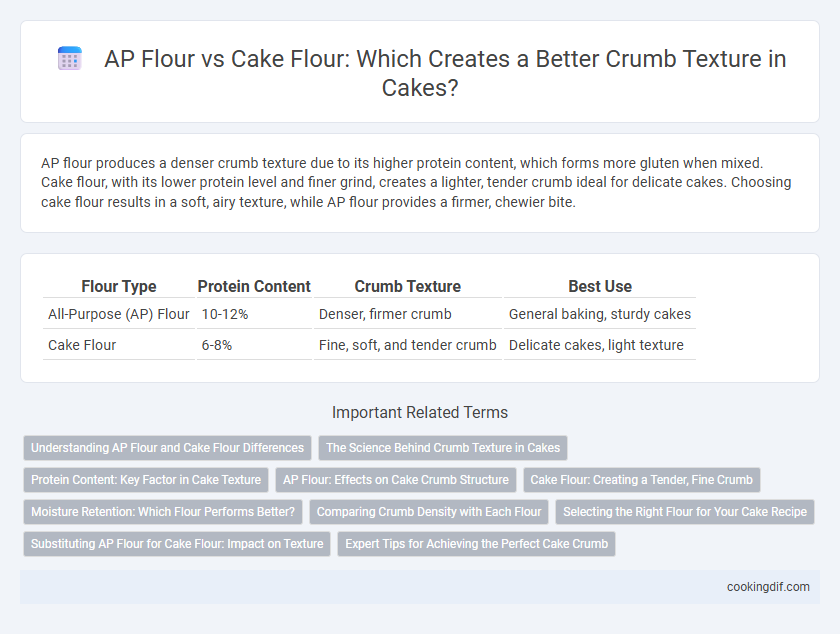AP flour produces a denser crumb texture due to its higher protein content, which forms more gluten when mixed. Cake flour, with its lower protein level and finer grind, creates a lighter, tender crumb ideal for delicate cakes. Choosing cake flour results in a soft, airy texture, while AP flour provides a firmer, chewier bite.
Table of Comparison
| Flour Type | Protein Content | Crumb Texture | Best Use |
|---|---|---|---|
| All-Purpose (AP) Flour | 10-12% | Denser, firmer crumb | General baking, sturdy cakes |
| Cake Flour | 6-8% | Fine, soft, and tender crumb | Delicate cakes, light texture |
Understanding AP Flour and Cake Flour Differences
All-purpose (AP) flour and cake flour differ primarily in protein content, with AP flour containing around 10-12% protein and cake flour having about 7-9%, which impacts gluten development and crumb texture. Cake flour's lower protein and finer milling result in a softer, more tender crumb, ideal for delicate cakes. Using AP flour tends to produce a denser, chewier texture, making cake flour the preferred choice for light, airy baked goods.
The Science Behind Crumb Texture in Cakes
AP flour contains higher protein content (10-12%) compared to cake flour (6-8%), which forms more gluten when mixed with liquid, resulting in a denser and chewier crumb in cakes. Cake flour's lower protein and finer milling produce less gluten development, yielding a softer, tender, and finer crumb texture ideal for delicate cakes. The starch granules in cake flour also gelatinize more efficiently, contributing to crumb lightness and moisture retention.
Protein Content: Key Factor in Cake Texture
AP flour contains about 10-12% protein, producing a denser, chewier crumb due to stronger gluten development, whereas cake flour, with 7-9% protein, yields a softer, more tender crumb ideal for delicate cakes. The lower protein content in cake flour minimizes gluten formation, resulting in a fine, light texture that enhances crumb softness. Choosing the appropriate flour based on protein levels directly influences the cake's final crumb texture and overall moistness.
AP Flour: Effects on Cake Crumb Structure
AP flour, with its higher protein content of 10-12%, develops more gluten during mixing, resulting in a denser and chewier cake crumb structure compared to cake flour. The increased gluten formation in AP flour strengthens the batter, providing more elasticity but often sacrificing the tender, fine crumb texture desired in delicate cakes. Using AP flour can produce cakes with a firmer bite and more pronounced crumb, which works well for heartier cake types but may reduce softness.
Cake Flour: Creating a Tender, Fine Crumb
Cake flour, with its lower protein content of around 7-8%, produces a tender, fine crumb ideal for delicate cakes. The reduced gluten formation ensures softness and a light, airy texture, unlike all-purpose flour which yields a denser, coarser crumb. Using cake flour enhances crumb structure by absorbing moisture efficiently and promoting even rise during baking.
Moisture Retention: Which Flour Performs Better?
Cake flour outperforms all-purpose flour in moisture retention due to its lower protein content and finer grind, resulting in a more tender and moist crumb texture. All-purpose flour, with higher gluten-forming proteins, tends to produce a denser crumb that can be drier over time. For baked goods requiring superior moisture retention and a delicate crumb, cake flour is the preferred choice.
Comparing Crumb Density with Each Flour
AP flour produces a denser, chewier crumb due to its higher protein content, which develops more gluten during mixing. Cake flour, with lower protein levels and finer milling, yields a lighter, softer, and more tender crumb ideal for delicate cakes. Choosing cake flour results in a less compact crumb texture, promoting a finer crumb structure with improved moisture retention.
Selecting the Right Flour for Your Cake Recipe
AP flour has higher protein content (10-12%) compared to cake flour (6-8%), resulting in a denser crumb texture suited for hearty cakes. Cake flour's lower protein and finer grind produce a tender, soft crumb ideal for delicate sponge cakes. Selecting cake flour enhances moisture retention and crumb softness, while AP flour provides structure and chewiness depending on recipe requirements.
Substituting AP Flour for Cake Flour: Impact on Texture
Substituting all-purpose (AP) flour for cake flour often results in a denser, coarser crumb texture due to AP flour's higher protein content, which promotes more gluten development. Cake flour's lower protein and finer milling create a tender, delicate crumb ideal for cakes. Adjusting AP flour by removing some protein through methods like replacing a portion with cornstarch can help mimic cake flour's soft texture in baking.
Expert Tips for Achieving the Perfect Cake Crumb
AP flour has a higher protein content of around 10-12%, which develops more gluten and produces a denser, chewier cake crumb, while cake flour contains about 7-9% protein, resulting in a lighter, softer texture. Expert bakers recommend sifting cake flour multiple times to aerate it, enhancing crumb tenderness and crumb structure uniformity. For best results, substitute 2 tablespoons of cornstarch per cup of AP flour to mimic cake flour's low protein, yielding an exquisitely fine and delicate crumb.
AP Flour vs Cake Flour for crumb texture Infographic

 cookingdif.com
cookingdif.com